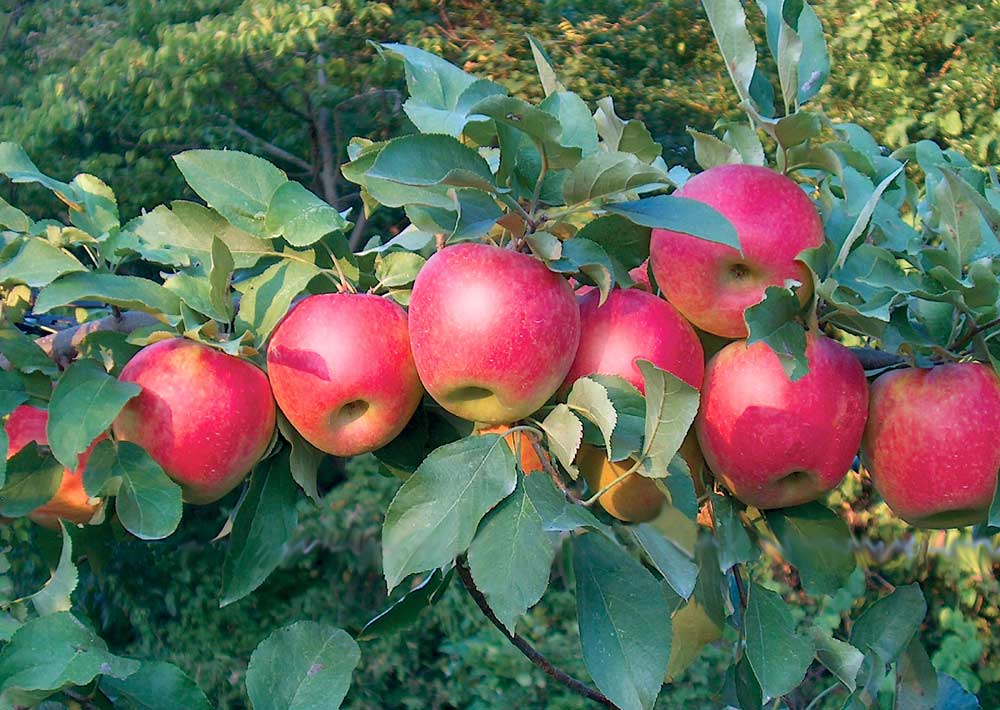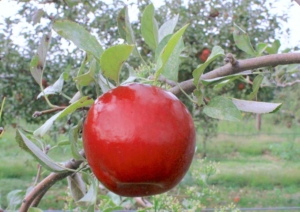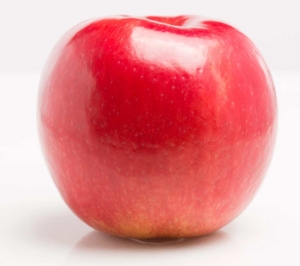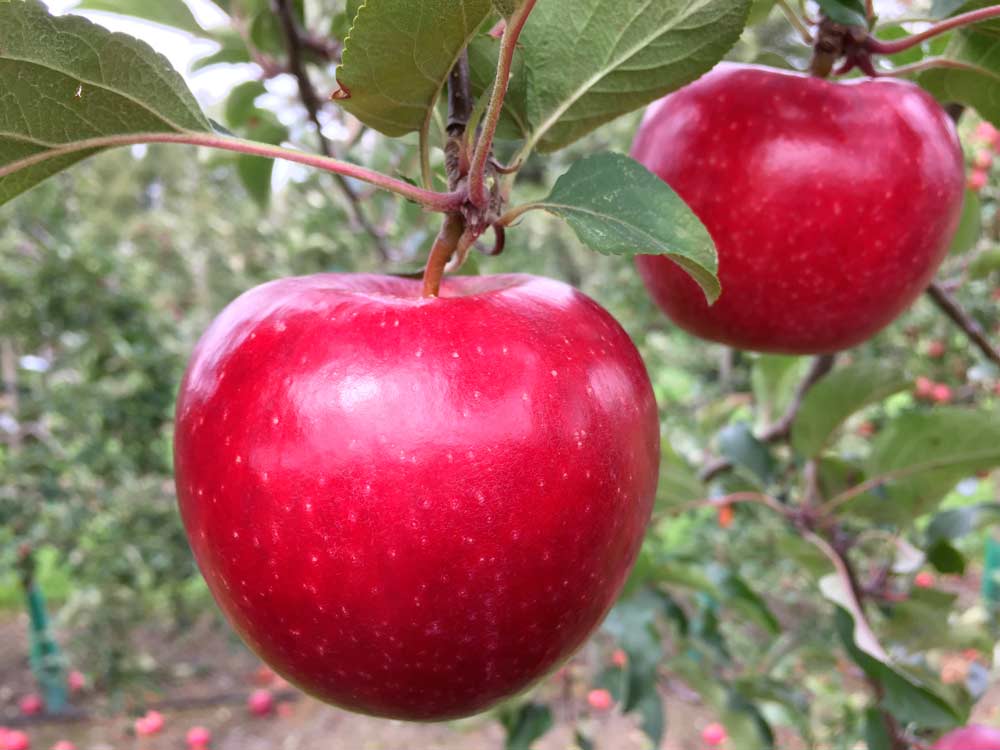
The Midwest Apple Improvement Association (MAIA) has been busy with new varieties, including these two: the yellow Crunch-a-Bunch, which is popular in the cider arena, and the red Bakers Delight that has flavor likened to a strawberry milkshake. Both varieties were launched by Gurney’s Seed and Nursery Co. in mid-November. (Photo by Jen Nova, courtesy of Gardens Alive!)
Appealing taste profiles, earlier harvesting and southern expansions are some of the characteristics of the many new apples making their way into offerings this year.
Beyond Cosmic Crisp, which is causing a stir in Washington, a number of other apples are pushing their way into this increasingly dynamic field.
One of them is MAIA 1. Apples from MAIA 1 will be sold under the branded name EverCrisp, which is a product of the Midwest Apple Improvement Association (MAIA).
“It’s one of the most refreshing apples I’ve ever eaten,” said Randy Beaudry, Ph.D., professor in the Michigan State University Department of Horticulture. “And because we use so many techniques nowadays, such as CA storage, dynamic CA storage and 1-MCP that suppress ripening, you need a variety that is not absolutely dependent on the aroma profile, but rather has that fresh mouth flavor. EverCrisp has that.” (Read “EverCrisp off to a good start”)
The MAIA is also rolling out four additional apples. They include Crunch-A-Bunch and Bakers Delight, which were launched in mid-November by Gurney’s Seed and Nursery Co. of Greendale, Indiana.
Gurney’s puts its focus on home gardeners who are looking for apples that are different from those available at the grocery store, and both of these fit the bill, said Felix Cooper, vice president of horticulture for Gurney’s. Only a few thousand of the trees are available in the first year, but he expects a major uptick in availability (10,000 to 20,000 each) for Crunch-A-Bunch in 2019 and for Bakers Delight a year later.
Crunch-a-Bunch is actually an early Gold Rush, a crunchy yellow apple with a following among cider enthusiasts.
Cooper describes Crunch-a-Bunch as possessing the same “effervescent,” somewhat tropical taste palette of Gold Rush, but with less-pronounced lenticels for a more attractive appearance and, most notably, an earlier harvest date and far superior flesh texture.
“It ripens right after Honeycrisp, so it’s a very attractive harvest window,” he said. “Its tree habit has a nice open form, and it’s that way right out of the gate, so it’s an easy tree form to manage.”
Bakers Delight, a cross of Gold Rush x Sweet 16, is well suited to those seeking something out of the ordinary, Cooper said.
“It’s very fruity and has a flavor profile similar to a strawberry milkshake.” It isn’t as crisp as Crunch-A-Bunch, but has a good texture and makes what he describes as “phenomenal baked goods” that showcase its one-of-a-kind fruitiness.
The other two new MAIA varieties are Honeycrisp x Fuji crosses that both share the Honeycrisp texture that consumers crave.
Currently known as MAIA 11 and MAIA 12, their names are being trademarked and should be announced by early summer, according to Bill Dodd, MAIA executive director.
He described MAIA 12 as similar to Honeycrisp in flavor, but without the bitterpit issues that can appear in Honeycrisp and with better performance in southern regions where growers often have a hard time coloring Honeycrisp.
“In places like western New York and the Ridge in Michigan, MAIA 12 will do fine, but for those people who don’t have the luxury of being in the best apple-growing regions, we think this one might fill that niche,” Dodd said. In comparison, MAIA 11 ripens slightly later and is not as sweet as MAIA 12. “It also seems to be a consistent cropper, so it’s not biennial,” he added.
Four new Honeycrisp crosses

Stark Scarlet Crush is Honeycrisp x Pink Lady cross that adds a bit of citrus to its sweet flavor and is said to grow as far south as Zone 7. (Courtesy Stark Bro’s.)
This spring, Stark Bro’s Nurseries & Orchards Co. of Louisiana, Missouri, introduced four new apples, all of which have Honeycrisp in their parentage and originated with growers rather than a breeding program.
“The early thinking on each of these from a product development life cycle is to introduce them to the consumer market, get some traction on them, and start building our supply of budwood over time so that we can support the commercial market,” said Ken Lane, Stark Bro’s chief marketing officer.
Two of the four varieties are Stark Scarlet Crush and Stark Ruby Darling.
Stark Scarlet Crush is described as a rosy-red Honeycrisp and Pink Lady cross that combines sweetness with tinges of citrus, and Ruby Darling is a Honeycrisp and Buckeye Gala cross that grows to a 3- to 4-inch, cherry-red, aromatic apple with a sweet, refreshing finish.
Neither apple readily browns, which is a benefit for buffets and other home uses, and, perhaps most significantly, both appear to grow well as far south as Zone 7, Lane said.

Stark Red Romance is a crunchy Honeycrisp x Buckeye Gala cross. (Courtesy of Stark Bro’s.)
The other two newly launched varieties from the company are Stark Red Romance, which is an exceptionally crunchy fruit, and Stark Hart’s Fancy, which has a rich ruby color, Lane said. Both are Honeycrisp and Buckeye Gala crosses.
For all four varieties, Stark Bro’s entire 2017 and 2018 crops are sold or otherwise spoken for. They will begin budding the 2019 crop this summer but are still accepting preorders.
Lane estimates that they will have budwood for 15,000 trees in 2019 and twice that in 2020.
Early ripening Rave

MN 55, the fruit of which will be marketed as Rave, is a new variety released from the University of Minnesota breeding program that introduced Honeycrisp. MN 55’s major attribute is its timing: It matures about a month before Honeycrisp. (Courtesy of Stemilt Growers Co.)
From the breeding program that developed Honeycrisp comes yet another: Rave.
“This will be the first year there will be fruit on the market,” reports David Bedford, apple breeder and senior research fellow at the University of Minnesota Horticultural Research Center.
Rave, the brand name for premium fruit produced from the MN55 cultivar, is a cross between Honeycrisp and an unreleased variety (AA 44) from the University of Arkansas. He describes the apple as having a very crisp and juicy texture with a pleasing sugar-acid balance, leaning a bit to the tart side.
“Its most unique feature is its earliness. I think it’s going to one of the earliest apples of good quality on the market,” Bedford said. “It’s not hard to produce early apples — there are plenty of them in discard piles all around the world — but this one breaks new ground because it has that Honeycrisp texture about a month before Honeycrisp is ripe.”
Stemilt Growers of Wenatchee, Washington, has been awarded the exclusive license for production and marketing in the United States, and the company is producing Rave as a managed variety that will be grown predominantly on Stemilt-managed orchards.
Minnesota growers will also be able to grow MN55, but their apples will be marketed under a different brand name.
Stemilt communications manager Brianna Shales expects the typical Rave harvest to take place in late July, making it “the first apple to market from Washington in any given year.” She remarks, “As of 2017, apple season is no longer back-to-school timing; it’s in August.” Stemilt anticipates that it will bring about 20,000 cartons to market with the upcoming harvest. “It will be a quick season the first year, but that will change as volumes increase in the near future,” she said.
As time passes, Shales also expects growers will get a better handle on the variety. She said, “It’s one of those premium varieties that requires a little extra TLC, but it’s well worth the extra effort.”
International offerings
New varieties aren’t only arising from U.S. breeding programs.

PremA129 (to be licensed and sold as Dazzle) is a New Zealand variety that is a cross of Scired (a Gala x Splendour cross known as NZ Queen) and Sweetie (a Royal Gala x Braeburn cross). The tree is being propagated and distributed for trial plantings in the United States. (Courtesy Fruitcraft)
Two of the many international introductions that are drawing interest are the New Zealand offerings PremA129 (to be licensed and sold as Dazzle), which is a cross of Scired (a Gala and Splendour cross known as NZ Queen) and Sweetie (a Royal Gala and Braeburn cross), and Smitten, which has grandparents in Falstaff, Fiesta, Braeburn and Gala.
The New Zealand-based company Plant & Food Research, which is funded by and licensed to Prevar, developed both PremA129 and Smitten.
The marketing collaboration Fruitcraft holds production and marketing rights to PremA129 globally and will begin exporting its apples from New Zealand in 2018 with hopes to be exporting 1 million cartons by 2028, said Steve Potbury, Fruitcraft manager.
“That will certainly make it one of New Zealand’s more popular new apple varieties,” Potbury said. The company also is propagating and distributing trees for trial plantings in the United States and other apple growing regions around the world, he added, and “over the next five years, we expect to license partners in all the major apple-growing areas.”
With Smitten, Pegasus Premier Fruit Co. of Wenatchee, Washington, holds the exclusive license to produce and market the variety in the United States. Pegasus partner Randy Steensma said the company’s interest in Smitten stemmed from its search for new cultivars that would make choice managed varieties.
“We’ve always been on the lookout for exceptional varieties, and in our travels we came across and started watching this one New Zealand variety, which turned out to be Smitten,” Steensma recalled.
As time went by, he said Smitten hit all the right notes: exceptional flavor, high juice content, excellent firmness with a pressure test of 20 to 22 pounds, a good crunch, heavy bearing and no stem-end splitting as is sometimes seen in Gala.
Since winning the license for Smitten, Pegasus put in its own show orchard and started to spread the word about the new apple.
“Our goal is to give all growers access to the variety,” he said. Currently, Washington has 600,000 trees planted, and Michigan and New York growers are putting in 250,000 trees (Read “Switch decision”).
Which of these varieties will make the biggest splash? That’s hard to say, said MSU’s Beaudry.
“It’s great that we have all these apples that are being developed, but growers should keep in mind that it’s really only through long-term evaluation that we can determine some of the potential negative-quality attributes, such as storage issues or other sensitivities.” He added, “Things like that can arise because while the tree did very well at the breeding program’s orchard and may not have had any problems at all, you’re not growing it in that same place and keeping it under those same conditions.”
That said, Beaudry is seeing many high-quality fruits coming out of breeding programs throughout the United States, and some of them just might be the next apple to tantalize consumers and push the apple industry to new heights.
“There really are some very nice things coming out of breeding programs today from all over the country and around the world. I only wish there were something coming out of Michigan, too!” •
-by Leslie Mertz, Ph.D., a freelance writer based in Gaylord, Michigan.






Nice how can i get this
Will smitten or Braeburn grow in Southern Utah high desert heat? Long season, but low humidity and getting hotter! Do tell.